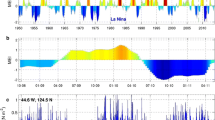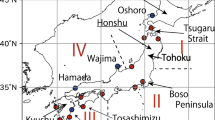Abstract
Sea level variability along the US West Coast is analyzed using multi-year time series records from tide gauges and a high-resolution regional ocean model, the base of the West Coast Ocean Forecast System (WCOFS). One of the metrics utilized is the frequency of occurrences when model prediction is within 0.15 m from the observed sea level, F. A target level of F = 90% is set by an operational agency. A combination of the tidal sea level from a shallow water inverse model, inverted barometer (IB) term computed using surface air pressure from a mesoscale atmospheric model, and low-pass filtered sea level from WCOFS representing the effect of coastal ocean dynamics (DYN) provides the most straightforward approach to reaching levels F>80%. The IB and DYN components each add between 5 and 15% to F. Given the importance of the DYN term bringing F closer to the operational requirement and its role as an indicator of the coastal ocean processes on scales from days to interannual, additional verification of the WCOFS subtidal sea level is provided in terms of the model-data correlation, standard deviation of the band-pass filtered (2–60 days) time series, the annual cycle amplitude, and alongshore sea level coherence in the range of 5–120-day periods. Model-data correlation in sea level increases from south to north along the US coast. The rms amplitude of model sea level variability in the 2–60-day band and its annual amplitude are weaker than observed north of 42 N, in the Pacific Northwest (PNW) coast region. The alongshore coherence amplitude and phase patterns are similar in the model and observations. Availability of the multi-year model solution allows computation and analysis of spatial maps of the coherence amplitude. For a reference location in the Southern California Bight, relatively short-period sea level motions (near 10 days) are incoherent with those north of the Santa Barbara Channel (in part, due to coastal trapped wave scattering and/or dissipation). At a range of periods around 60 days, the coastal sea level in Southern California is coherent with the sea surface height (SSH) variability over the shelf break in Oregon, Washington, and British Columbia, more than with the coastal SSH at the same latitudes.











Similar content being viewed by others
References
Allen JS, Denbo DW (1984) Statistical characteristics of the large-scale response of coastal sea level to atmospheric forcing. J Phys Oceanogr 14:1079–1094
Battisti DS, Hickey BM (1984) Application of remote wind-forced coastal trapped wave theory to the Oregon and Washington coasts. J Phys Oceanogr 14:887–903
Brink K (1982) The effect of bottom friction on low frequency coastal trapped waves. J Phys Oceanogr 12:127–133
Brink KH (1991) Coastal-trapped waves and wind-driven currents over the continental shelf. Ann Rev of Fluid Mech 23:389–412. doi:10.1146/annurev.fl.23.010191.002133
Chapman DC, Lentz SJ, Brink KH (1988) A comparison of empirical and dynamical hindcasts of low-frequency, wind-driven motions over a continental shelf. J Geophys Res 93:12,409–12,422
Chelton DB, Davis RE (1982) Monthly mean sea level variability along the west coast of North America. J Phys Oceanogr 12:757–784
Clarke AJ (1977) Observational and numerical evidence for wind-forced coastal trapped long waves. J Phys Oceanogr 1:231–247
Cutchin DL, Smith RL (1973) Continental shelf waves: low-frequency variations in sea level and currents over the Oregon continental shelf. J Phys Oceanogr 3:73–82
Denbo DW, Allen JS (1987) Large-scale response to atmospheric forcing of shelf currents and coastal sea level off the west coast of North America: May-July 1981 and 1982. J Geophys Res 92:1757–1782
Durski SM, Kurapov AL, Allen JS, Kosro PM, Egbert GD, Shearman RK, Barth JA (2015) Coastal Ocean variability in the US Pacific Northwest region: seasonal patterns, winter circulation, and the influence of the 2009–2010 El Niño. Ocean Dyn 65(12):1643–1663. doi:10.1007/s10236-015-0891-1
Egbert GD, Erofeeva SY (2002) Efficient inverse modeling of Barotropic Ocean tides. J Atmos Ocean Technol 19:183–204
Enfield, D. B., (1987): The interseasonal oscillation in Eastern Pacific sea levels: how is it forced? J. Phys. Oceanogr., 1860–1876.
Enfield DB, Allen JS (1980) On the structure and dynamics of monthly mean sea level anomalies along the Pacific coast of North and South America. J Phys Oceanogr 10:557–578
Erofeeva SY, Egbert GD, Kosro PM (2003) Tidal currents on the Central Oregon shelf: models, data, and assimilation. J Geophys Res 108(C5):3148. doi:10.1029/2002JC001615
Fairall CW, Bradley EF, Rogers DP, Edson JB, Young GS (1996) Bulk parameterization of air-sea fluxes for TOGA COARE. J Geophys Res 101:3747–3767
Gill AE, Clarke AJ (1974) Wind-induced upwelling, coastal currents and sea-level changes. Deep-Sea Res 21:325–345
Gill AE, Schumann EH (1974) The generation of long shelf waves by the wind. J Phys Oceanogr 4:83–90
Halliwell GR Jr, Allen JS (1984) Large-Scale Sea level response to atmospheric forcing along the west coast of North America, summer 1973. J Phys Oceanogr 14:864–886
Halliwell GR Jr, Allen JS (1987) Wavenumber-frequency domain properties of coastal sea level response to alongshelf wind stress along the West Coast of Norh America, 1980-1984. J Geophys Res 92:11,761–11,788
Huyer A, Hickey BM, Smith JD, Smith RL, Pillsbury RD (1975) Alongshore coherence at low frequencies in currents observed over the continental shelf off Oregon and Washington. J Geophys Res 80:3495–3504
Kim SY, Kurapov AL, Michael Kosro P (2015) Influence of varying upper ocean stratification on coastal near-inertial currents. J Geophys Res Oceans 120:8504–8527. doi:10.1002/2015JC011153
Kundu PK, Allen JS (1976) Some three-dimensional characteristics of low-frequency current fluctuations near the Oregon coast. J Phys Oceanogr 6:181–199
Kurapov AL, Foley D, Strub PT, Egbert GD, Allen JS (2011) Variational assimilation of satellite observations in a coastal ocean model off Oregon. J Geophys Res 116:C05006. doi:10.1029/2010JC006909
Maloney ED, Hartmann DL (2001) The Madden–Julian Oscillation, barotropic dynamics, and North Pacific tropical cyclone formation. Part I: observations. Mon. Wea. Rev. 58(17):2545–2558
Mass C, Dotson B (2010) Major extratropical cyclones of the Northwest United States: historical review, climatology, and synoptic environment. Mon Wea Rev 138:2499–2526
Mellor GL, Ezer T (1995) Sea level variations induced by heating and cooling: an evaluation of the Boussinesq approximation in ocean models. J Geophys Res 100(C10):20565–20577. doi:10.1029/95JC02442
Mellor GL, Yamada T (1982) Development of a turbulence closure model for geophysical fluid problems. Rev Geophys 20(4):851–875. doi:10.1029/RG020i004p00851
Mooers CNK, Smith RL (1968) Continental shelf waves off Oregon. J Geophys Res 73(2):549–557
Perlin, N., R. M. Samelson, and D. B. Chelton, (2004): Scatterometer and model wind and wind stress in the Oregon–Northern California coastal zone. Mon. Wea. Rev., 2110–2129.
Philander SGH, Yoon J-H (1982) Eastern boundary currents and coastal upwelling. J Phys Oceanogr 12:862–879
Roblou L, Lamouroux J, Bouffard J, Lyard F, Le Henaff M, Lombard A, Marsaleix P, De Mey P, Birol F (2011) Post-processing altimeter data towards coastal applications and integration into coastal models. In: Vignudelli S, Kostianoy AG, Cipollini P, Benveniste J (eds) Coastal altimetry. Springer-Verlag, Berlin. doi:10.1007/978-3-642-12796-0_9
Shchepetkin AF, McWilliams JC (2003) A method for computing horizontal pressure-gradient force in an oceanic model with a nonaligned vertical coordinate. J Geophys Res 108(C3):3090. doi:10.1029/2001JC001047
Shchepetkin AF, McWilliams JC (2005) The regional oceanic modeling systems (ROMS): a split-explicit, free-surface, topography-following-coordinate oceanic model. Ocean Model 9:347–404. doi:10.1016/j.ocemod.2004.08.002
Spillane MC, Enfield DB, Allen JS (1987) Intraseasonal oscillations in sea level along the west coast of the Americas. J Phys Oceanogr 17:313–325
Springer SR, Samelson RM, Allen JS, Egbert GD, Kurapov AL, Miller RN, Kindle JC (2009) A nested grid model of the Oregon coastal transition zone: simulations and comparisons with observations during the 2001 upwelling season. J Geophys Res 114:C02010. doi:10.1029/2008JC004863
Vinogradov SV, Ponte RM (2010) Annual cycle in coastal sea level from tide gauges and altimetry. J Geophys Res 115:C04021. doi:10.1029/2009JC005767
Wilkin JL, Chapman DC (1990) Scattering of coastal-trapped waves by irregularities in coastline and topography. J Phys Oceanogr 20:396–421
Wunsch C, Stammer D (1997) Atmospheric loading and the oceanic “inverted barometer” effect. Rev Geophys 35:79–107
Zhang, A., K. W. Hess, E. Wei, and E. Myers, (2006): Implementation of model skill assessment software for water level and current in tidal regions, NOAA Technical Report NOS CS 24, Silver Spring, MD, March 2006 (available online: http://www.nauticalcharts.noaa.gov/csdl/publications/TR_NOS-CS24_FY06_AJ_SkillAssessment.pdf).
Acknowledgements
We would like to thank Drs. J. S. Allen, K. Brink, and M. Fewings for stimulating discussions and suggestions toward the manuscript improvement. This research was partially supported by the NOAA WCOFS Grant, the NOAA Coastal Ocean Modeling Testbed (COMT) grant, the NASA SWOT Science Definition Team project, and the NSF grant #1030922.
Author information
Authors and Affiliations
Corresponding author
Additional information
Responsible Editor: Birgit Andrea Klein
Rights and permissions
About this article
Cite this article
Kurapov, A.L., Erofeeva, S.Y. & Myers, E. Coastal sea level variability in the US West Coast Ocean Forecast System (WCOFS). Ocean Dynamics 67, 23–36 (2017). https://doi.org/10.1007/s10236-016-1013-4
Received:
Accepted:
Published:
Issue Date:
DOI: https://doi.org/10.1007/s10236-016-1013-4




